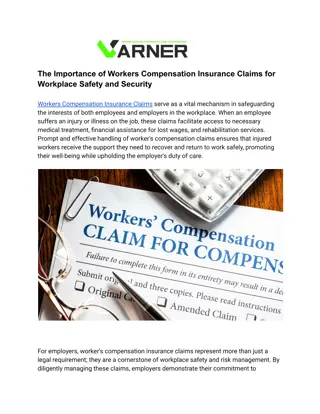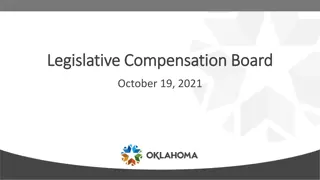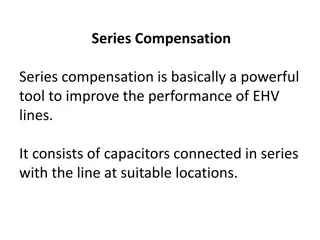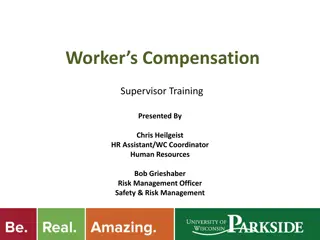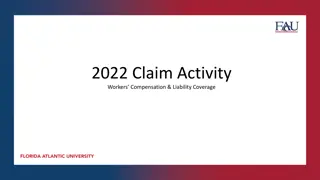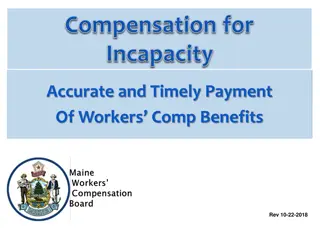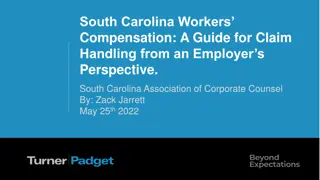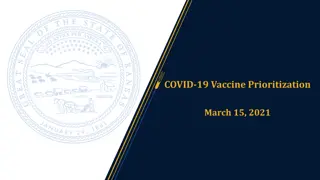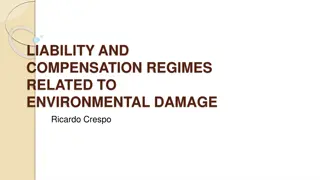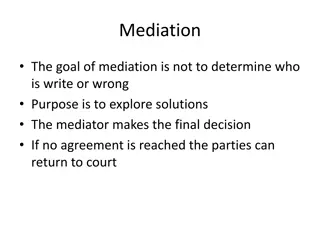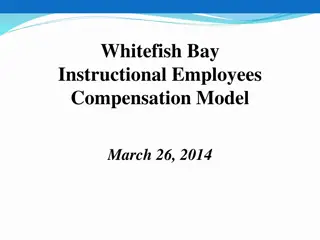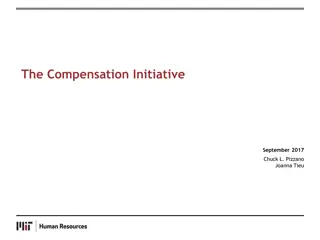Comprehensive Guide to Kansas Workers' Compensation Laws
This comprehensive guide covers various aspects of the Kansas Workers' Compensation laws, including the workers' compensation remedy, insurance requirements, applicability criteria, exceptions, compensable injuries, and medical benefits. It explains the exclusive, limited remedies available for different types of injuries, the requirements for employers to provide workers' compensation insurance, criteria for when workers' compensation applies, exceptions to coverage, types of disability benefits available, and the obligations of employers to provide medical benefits to injured employees.
Download Presentation

Please find below an Image/Link to download the presentation.
The content on the website is provided AS IS for your information and personal use only. It may not be sold, licensed, or shared on other websites without obtaining consent from the author. Download presentation by click this link. If you encounter any issues during the download, it is possible that the publisher has removed the file from their server.
E N D
Presentation Transcript
Kansas Workers Compensation Administrative Law ALJ Ken Hursh
The workers compensation remedy, K.S.A. 44-501b(d) Exclusive Limited o Temporary total o Permanent partial o Permanent total o Death o Medical $130K $130K (incl. ttd) $155K (incl. ttd) $300K/$100K unlimited Substitute Johnson v. U.S. Food Service, 312 Kan. 597 (2021)
Workers compensation insurance, who needs it? K.S.A. 44-508(a) Any employer with at least $20K annual (actual or anticipated) non-agricultural, non-family payroll. And if you don t have it? Workers compensation fund (KID), K.S.A. 44-532a Sub/general contractor up the chain K.S.A. 44-503 o Certificate of insurance problem Fund or sub/general contractor entitled to subrogation from uninsured employer. Uninsured employer subject to fraud and abuse penalty.
When does workers compensation apply? K.S.A. 44-508(d) and (e): A lot of words amounting to work related injury. And (jurisdiction) the injury occurred within the state, or the contract of employment was made within the state, K.S.A. 44-506.
Exceptions Injury not reported to employer within 20 days of injury, or 10 days of last date of employment, K.S.A. 44-520. Intoxication contributed to the injury, K.S.A. 44-501(a). Injury caused by failure to use a safety device or to follow a written safety rule, K.S.A. 44- 501(a).
Compensable injury, what is owed? Disability benefits (Acronym City) Temporary total disability (TTD), K.S.A. 44-510c(b). When you re unable to work, but you re working on getting better. Temporary Partial disability (TPD) working reduced wages. Permanent partial disability (PPD), K.S.A. 44-510d and 44-510e. When you re as good as you re going to get (you ve reached MMI), you re not as good as you were before, but you re still capable of working. o Scheduled injury/non-scheduled injury distinction. Permanent total disability (PTD), K.S.A. 44-510c(a). When you re at MMI and incapable of working, period. Death benefits, K.S.A. 44-510b. Depends on dependents. All disability benefits are determined on a weekly basis, based on the average weekly wage (K.S.A. 44-511 salary or 26 week pre-injury average). Same as unemployment weekly benefit rate 2/3 average weekly wage subject to an annually adjusted maximum.
Medical benefitsthe biggest dollars. K.S.A. 44-510h(a) o It shall be the duty of the employer to provide the services of a health care provider, and such medical, surgical and hospital treatment, including nursing, medicines, medical and surgical supplies, ambulance, crutches, apparatus and transportation to and from the home of the injured employee to a place outside the community in which such employee resides, and within such community if the director, in the director s discretion, so orders, including transportation expenses computed in accordance with subsection (a) of K.S.A. 44-515, and amendments thereto, as may be reasonably necessary to cure and relieve the employee from the effects of the injury. Case law side effects Separate injury that is a direct and natural consequence of the original work injury is compensable as part of the original injury. Chinn v. Gay & Taylor, Inc., 219 Kan. 196, 547 P.2d 751 (1976). The standard for whether a psychological injury, or traumatic neurosis, is compensable under workers compensation is that the psychological injury must be directly traceable to a compensable physical injury, Gleason v. Samaritan Home, 260 Kan. 970, 926 P.2d 1349 (1996).
Courtroom procedures Preliminary hearings most of the ALJ work, K.S.A. 44-534a. May be held only for issues regarding medical or temporary benefits (the claim s early stages, typically). Hearsay allowed Appealable only if compensability was an issue. Regular or full hearing, K.S.A. 44-534 Claimant only testifies (typically) at initial in-person hearing, then Terminal dates are set for submitting additional evidence by deposition. ALJ writes a final award of all the various benefits. o Always appealable. o Pre-hearing settlement conference; independent medical examination (IME). Hearings after final award o Post Award Medical, K.S.A. 44-510k o Review and Modification, K.S.A. 44-528 Dismissal hearings, K.S.A. 44-523(f) Penalties hearings, K.S.A. 44-512a, 44-512b
Appeals procedures Workers Compensation Appeals Board, K.S.A. 44-555c. Always de novo review All Board decisions subject to Kansas judicial review act, K.S.A. 44-566. Court of Appeals Supreme Court
Lockdown effects on hearing procedures Went from all in-person hearings to all conference call to some Zoom to, now, some of all three. Advantages/disadvantages to all: Conference call o No travel required o Anyone can access o Hard to take evidence (transcribing), hence, delays Zoom o Little or no travel required o Everyone has a face easier to see who s talking, interject o Much better for transcription o Computer access required o Only see a face In-person o Best communication, everybody sees evidence o Best customer service o Requires travel Death of the local attorney ?
The 6thEditionAll the Rage K.S.A. 44-510d and 44-510e say, in relevant parts: (510d) Loss of or loss of use of a scheduled member shall be based upon permanent impairment of function to the scheduled member as determined using the fourth edition of the American medical association guides to the evaluation of permanent impairment, if the impairment is contained therein, until January 1, 2015, but for injuries occurring on and after January 1, 2015, shall be determined by using the sixth edition of the American medical association guides to the evaluation of permanent impairment, if the impairment is contained therein. (510e) The extent of permanent partial general disability shall be the percentage of functional impairment the employee sustained on account of the injury as established by competent medical evidence and based on the fourth edition of the American medical association guides to the evaluation of permanent impairment, if the impairment is contained therein until January 1, 2015, but for injuries occurring on and after January 1, 2015, based on the sixth edition of the American medical association guides to the evaluation of permanent impairment, if the impairment is contained therein.
Difference between 4thand 6thEditions Wiggle room o 4thDiagnosis Related Estimates (DRE) vs. Range of Motion Model (ROM) o 6thDRE-ish grid, only a few percentage points up or down Claimant attorney s ability to benefit client and earn a fee Good for respondent/insurer
Substitute Remedy (Revisited) Are benefits under the 6thEdition so low workers compensation is not an adequate substitute for the exclusive remedy? Johnson v. U.S. Food Service Court of Appeals, 56 Kan. App. 2d 232, 427 P.3d 996 (2018), in relevant parts . . .our Kansas Workers Compensation Act no longer provides an adequate substitute remedy for injured workers who suffer a permanent impairment on or after January 1, 2015, and K.S.A. 2015 Supp. 44-510d(b)(23) and (b)(24) and K.S.A. 2015 Supp. 44- 510e(a)(2)(B) violate the constitutional requirement for due process. . . . . . Such a remedy will effectively reinstate the use of the Fourth Edition as the basis for determining impairment ratings. . . Supreme Court, 312 Kan. 597 (2021), in relevant parts . . . The use of the phrase "based on" indicates the Legislature intended the Sixth Edition to serve as a standard starting point for the more important and decisive "competent medical evidence . . . . . . The 2013 amendments merely reflect an update to the most recent set of guidelines which serve as a starting point for any medical opinion. K.S.A. 2019 Supp. 44-510e(a)(2)(B) has never dictated that the functional impairment is set by guides. This has not changed. The key fact percentage of functional impairment must always be proved by competent medical evidence. . .






